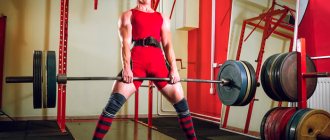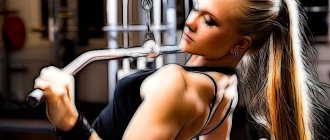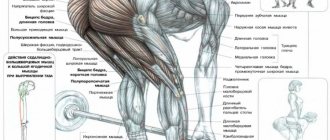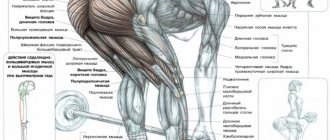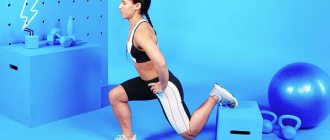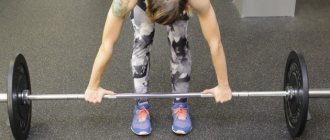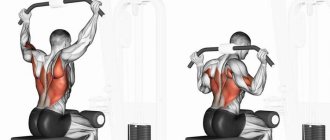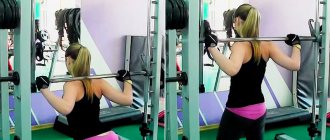The deadlift or dead lift is one of the varieties of the classic deadlift, which is so called because it is performed on straight legs, without bending the knees, literally tightly. This version of the deadlift is not a weightlifting exercise, but is widely used when building muscle mass in the gym, especially for women. This is due to the fact that deadlifts develop the gluteal muscles and hamstrings, the favorite muscles of the fairer sex, without involving the quadriceps. Next, we will consider the technique of performing deadlifts, Romanian and their main differences from the classical deadlift.
Where did these names come from?
First, let's look at the main differences between deadlifts and Romanian deadlifts. If the dead lift is performed with straight legs, then the Romanian deadlift is performed with the knees bent to about 15 degrees. The classic deadlift was the main exercise in weightlifting, and the Romanian deadlift appeared thanks to Romanian weightlifters practicing this technique. Judging by the fact that their athletes always stood out and took high places, the Romanian deadlift technique began to be used everywhere. Next, a variant of the Romanian deadlift appeared, which began to be performed with straight knees for greater stretching and involvement of the hamstrings in the work.
Essentially, the Romanian and deadlift are the same exercise, and the angle of knee flexion depends on the stretch of the hamstrings.
What is the difference between deadlift and Romanian
Both options involve bending the knees, but the difference between them is fundamental. In a classic deadlift, the movement is more similar to a squat, and the angle at the knees approaches 90 degrees. Deadlifts are performed mainly through the back, also involving the quadriceps of the thigh. In Romanian, the pelvis is primarily tilted and abducted, which is accompanied by slight bending of the knees, up to about 10-15 degrees. And the main muscles during the Romanian deadlift are the gluteal and lumbar extensors, without involving the quadriceps.
Difference between deadlift and deadlift
Two completely different movements. As already mentioned, the classic deadlift is performed with bending the knees, and the deadlift on straight legs, respectively, without bending the knees. If in the classical one the latissimus dorsi muscles, its extensors and quadriceps work to a greater extent, then in the dead one the hamstrings and gluteal muscles are subjected to great stretching, but the quadriceps do not work.
Execution technique
One simple life hack will help you perform this movement technically correctly. To begin, learn to lean forward with a straight back while standing on straight legs. The position of the hands is moving along the hips.
The order of execution is as follows:
- The barbell is taken from the racks with a straight grip or a lock grip; if necessary, straps are used. The grip is not a fundamentally important point of the exercise; greater concentration is required on the work of the legs and buttocks;
- While inhaling, bend forward with a straight back, due to flexion at the hip joint;
- The knee joints are straightened and “locked,” as it were; there is no need to move your knees;
- The depth of the tilt is determined by the ability to maintain a straight back; as soon as the back begins to bend in the lumbar region, you need to start moving up;
- Allowable tilt depth is any amplitude below the knee;
- Extension occurs as you exhale;
- The movement is performed the required number of times, movement in the knees is excluded;
- You should not throw your head back, you should try to keep it neutral, the neck is an extension of the spine, you should not look at the ceiling, as some athletes do when lifting heavy weights in the classical deadlift.
Important: you should not even try to lift the same weight in this exercise that you could lift in a classic deadlift.
Deadlift - execution technique.
The benefits and harms of deadlifts on straight legs
Thanks to the straight leg technique, the flexibility and elasticity of the muscles of the back surface of the body increases. This allows you to safely perform complex compound exercises that require a good stretch of these muscles, such as deep squats and other pulling exercises.
When the muscles of the posterior surface of the body are shortened, when they are in hypertonicity, hyperlordosis of the lumbar region, protrusion of the abdomen and forward displacement of the pelvis more often appear. Deadlifts allow you to stretch shortened muscles, return them to their normal physiological state and strengthen the stabilizers - the gluteal muscles, which are in an atonic state. Therefore, straight-legged deadlifts improve spinal health and posture.
If the muscles are too tight and experience pain when performing deadlifts on straight legs, you should replace the exercise with a safer one that does not stretch the hamstrings as much. Inelastic hamstrings - the biceps femoris, semitendinosus and semimembrane muscles are severely injured when stretched, and the technique leaves much to be desired, since it is impossible to perform the exercise with the required amplitude.
Therefore, the dead lift should be performed only if you have flexible and elastic muscle fibers.
Also, weak abdominal muscles do not allow the lower back to be fixed in a natural deflection, which causes it to become rounded. And when working with weights, there is a strong load on the vertebrae with further traumatization.
Maintaining the correct technique and position of the lower back in a natural deflection will prevent injuries and back pain.
Deadlift
Deadlift on straight legs is a slightly more complex exercise and strong back muscles are a necessary and very important condition for its implementation. If you have any injuries to the lumbar region or back, then performing this exercise becomes questionable. If you don’t have any restrictions, then alternate your workouts using classic and Romanian deadlifts.
Training Tips:
- Incorporate deadlifting exercises 1-2 times a week into your workouts.
- Do 3-4 sets of 10-15 repetitions, depending on the weight on the bar.
- With increasing weight on the bar, it is better to reduce the number of repetitions to 6-8 per approach.
- Alternate between light and heavy deadlift workouts.
- Rest after deadlift exercises should be at least 3 days.
Remember: the weight on the bar should increase slowly but surely.
Don't forget to wear a belt, even if the weight on the bar is light. This way you will securely secure your lower back and reduce the risk of sprains.
Knowing the technique and understanding all the advantages of this exercise, you ladies will give your legs slimness, your buttocks elasticity, and your back a strong and even posture. Only advantages! Go for it. And be proud of yourself!
Publication date: February 18, 2021.
The exercise is basic and involves the hips and buttocks.
What muscles work
Main muscles:
- Spinal extensors.
- Large gluteal muscles.
- Biceps femoris muscles.
Stabilizing the spine also involves the rectus abdominis, trapezius, and forearms.
Technique for performing deadlifts with a barbell
- Place the barbell in the power rack at hip level, select a suitable load weight, do not take too much weight, as this will injure the hamstrings.
- Grasp the bar with an overhand grip, shoulder-width apart.
- Remove the bar, take a couple of steps back and place your feet hip-width apart, parallel to each other.
- Look in front of you, gather your shoulder blades and tighten your abdominal muscles.
- As you inhale, tilt your body forward while simultaneously moving your pelvis back without bending your knees. The body weight should shift to the heels.
- Your back should be in a slight arch; to do this, pull your tailbone back and tense your abs. Arms straight and relaxed.
- The forward tilt of the torso depends on the degree of muscle flexibility; it is enough to lower the bar, which runs straight along the hips, to approximately the middle of the shin.
- As you exhale, push off with your heels and straighten your straight back in reverse order using your gluteal muscles and lumbar extensors.
- At the top point, straighten up completely.
- Continue the movement for the required number of repetitions without experiencing any acute pain. At the end of the set, return the bar to the power rack.
Romanian Deadlift Technique at Smith
The above technique can also be performed in Smith. Using an example, let's look at the Romanian deadlift with bent knees. The Smith machine makes it easier to perform deadlifts because the bar is mounted on guides, making it easier to control pelvic abduction and tilt.
- Place the bar on the clamps of the machine at hip level.
- Stand in the center of the bar and grab it from above, shoulder width apart. Turn the locks and remove the bar from the clamps.
- There is very little distance between the feet and the bar; the bar should slide along the shin. Place your feet parallel to the width of your pelvis.
- Look in front of you and, as you inhale, tilt your body, moving your pelvis back and at the same time bending your knees, but not too much; the exercise is performed as a tilt, not a squat.
- Bring the bar to its maximum point at the bottom, but do not round your back. The inclination depends on the degree of muscle stretching.
- Exhale and straighten your torso, knees and pelvis in the upper position.
- After completing the approach at the top point, rotate the bar and secure.
Interesting Facts
Follow the correct technique, do not chase heavy working weights
The Romanian deadlift became known to the general public relatively recently. In 1990, an athlete from Romania, Niculae Vlad, was training in San Francisco.
When working the muscles of the back and legs, the athlete used a modified deadlift, in which the knees did not bend, and the bar was brought only to the upper third of the shin.
Although the exercise was not invented by Vlad Niculae himself and was not the development of his coaches, it became associated with Romanian weightlifters, which gave this type of deadlift its name.
The deadlift can be used to assess an athlete's strength - one way or another it involves all muscle groups. But in powerlifting competitions, the deadlift is used instead: it allows you to lift more weight, and is less likely to cause injury.
The leg muscles make up approximately half of the muscle mass. They need to pay a lot of attention during training. On the one hand, this will make the body proportional, on the other hand, it will contribute to the growth of the muscles of the upper body.
At the same time, many people forget about the back of the thighs and buttocks, focusing on the calves and quadriceps, but in fact, the hamstrings and gluteal muscles need to be given enough time.
No other exercise has such an effect on the development of these muscles as the deadlift.
Deadlift technique in a crossover
Deadlifts and Romanian deadlifts are also performed in the lower block of the crossover. Of course, the barbell is the most preferred equipment, as it is a free weight. The lower block is not designed for vertical movement of the handle along the shin, so you have to move back; accordingly, the block pulls your arms forward and pulls the body behind it.
- Grab a straight handle shoulder-width apart while facing into a crossover.
- Take a few steps back while pulling on the cable.
- Place your feet hip-width apart, tighten your abs and keep your lower back in a natural arch throughout the entire approach.
- As you inhale, tilt your body forward, moving your pelvis back, transferring your center of gravity to your heels. Don't bend your knees. The arms are freely extended behind the block with the handle, but it is important to ensure that the weight does not pull the body forward and does not shift the load to the toes.
- As you exhale, straighten your torso, pushing off with your heels, and fully straighten all joints at the top point.
Recommendations: how to perform deadlifts for girls and men
Both men and women are not recommended to perform deadlifts with maximum weights, since the biceps and ligaments already experience severe stretching; they should not be injured by working weights as in the classic deadlift. Think of the dead lift as an auxiliary exercise to tone your biceps and glutes. Perform it extremely carefully within 15-25 repetitions of 3 sets.
More trained representatives of the stronger sex can perform the exercise for 12-14 repetitions of 3-4 approaches. The exercise should only be performed after compound compound exercises that involve more muscles, such as barbell squats and leg presses.
If the exercise causes severe pain in the hamstrings, replace it with the Romanian deadlift, which will relieve the stretch.
Should it be used in training?
To create a beautiful leg relief, isolated training of the muscles of the back of the thigh and buttocks is necessary. Various squats primarily involve the quadriceps, which takes the lion's share of the load.
And special exercise machines cannot be found in all gyms. Therefore, the Romanian (dead) lift is considered as a basic exercise when working on the leg muscles.
This is one of the main exercises in bodybuilding. It is similar to the deadlift, but differs in that it requires you to keep your legs straight or only slightly bend them as the weight is lowered down.
The exercise works well on the buttocks and back of the thighs. It also works your back, arms and shoulders. Thus, the deadlift is basic, unlike, for example, leg curls in a lying hamstring machine.
What muscles work?
When performing the exercise, the back of the thigh, buttocks and back are involved:
How to replace dead rods at home
At home, if you don’t have a barbell, you can perform the exercise with dumbbells, kettlebells, fitness bands and balls.
Deadlift with elastic band
Both a rubber band and an expander ring band are suitable for this exercise. It is necessary to step with your feet on the lower edge of the ring elastic or the middle of the tape, selecting a certain degree of tension, and grab the free edges. The stronger the stretch, the stronger the load. When you bend down, the band contracts, and when you straighten your torso, it creates the necessary resistance.
Deadlift with dumbbells
The technique remains the same; you need to hold dumbbells in both hands, placing them in front of your hips with your palms facing you.
Deadlift with kettlebell
The handle of the kettlebell must be held with both hands, taking the starting position, as in the deadlift with a barbell.
Read more about kettlebell deadlifts →
Deadlift with medicine ball
The medicine ball serves as a weight depending on its weight. To perform the exercise, hold the ball between your palms at your sides. Rowing with the ball occurs in the same way as with a barbell; the ball slides along the shin.
The best exercises with a medicine ball →
Unique secrets of “power” deadlifting for powerlifters
The theoretical methodology itself cannot be ideal, since the athlete may have many questions about the details of the exercise. It is for this purpose, based on monitoring common questions among powerlifters, that this section was created.
Complete your exercise with the following nuances:
- Never perform this exercise without warming up your muscles. Do deadlifts after your body has warmed up through your regular workout routine; — The starting position of the body is the athlete’s stance, shoulder-width apart, with the toes of the feet under the bar; — The grip of the bar must be wider than the position of the legs. In this case, use a different type of grip, grab the bar with one hand from above and the other from below. - Watch your back. When performing a “power” pull, the back should always remain straight. If during this exercise you notice that your back begins to round, then you should additionally select a set of exercises that will help train your back flexibility. — Always maintain a balanced (stable) posture, do not make sudden movements. Perform all phases of the deadlift as smoothly as possible, without sudden jolts.
For those who have already tried deadlifts! You can only increase the weight of the barbell when you have thoroughly honed your deadlift technique. To do this, you need to consult with a powerlifting coach.


